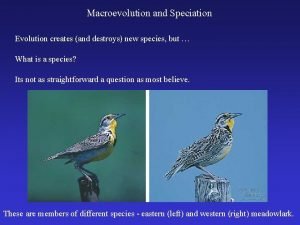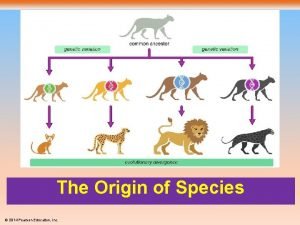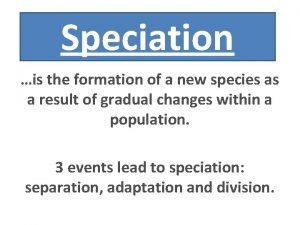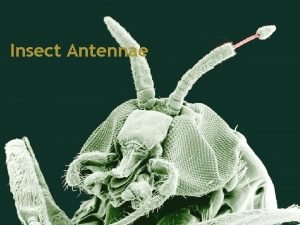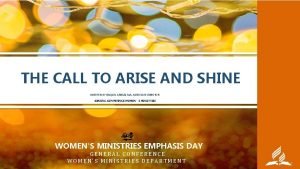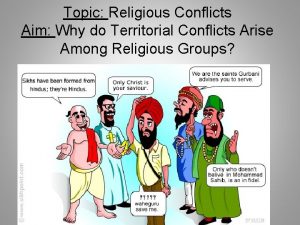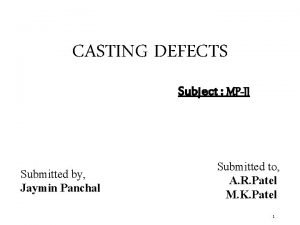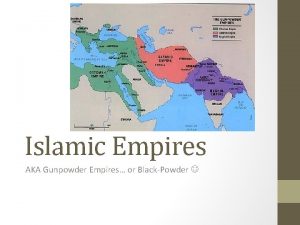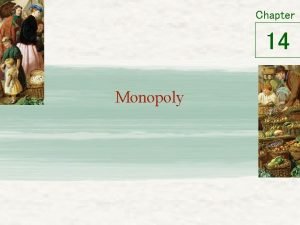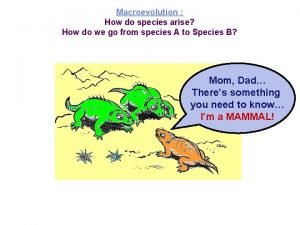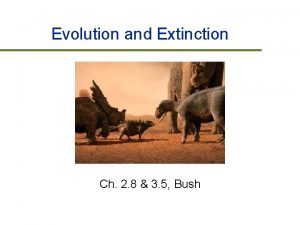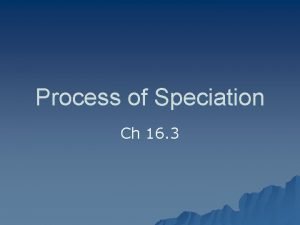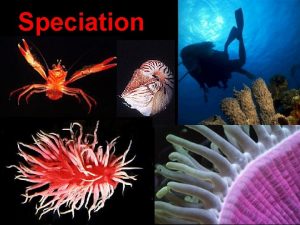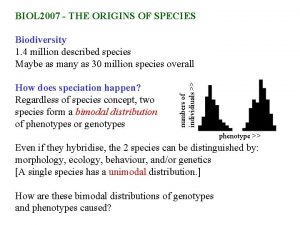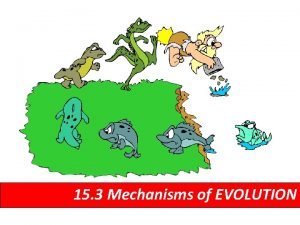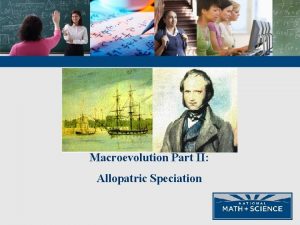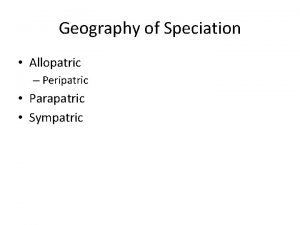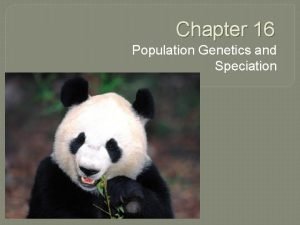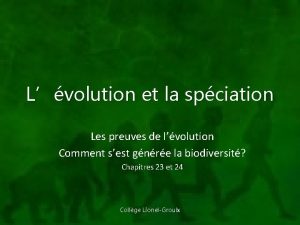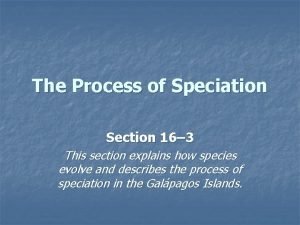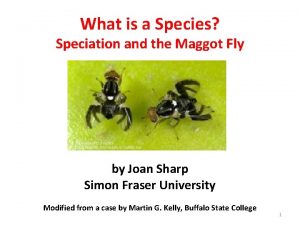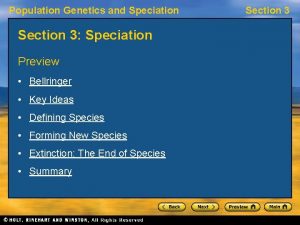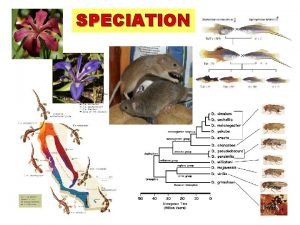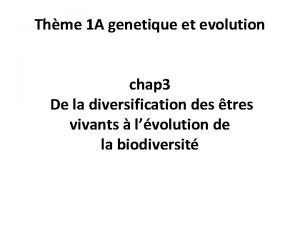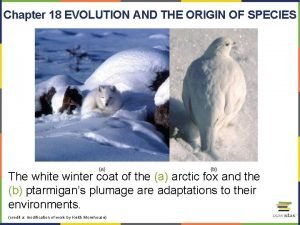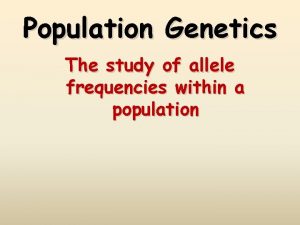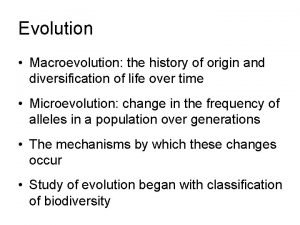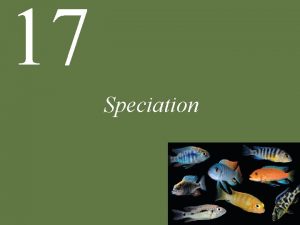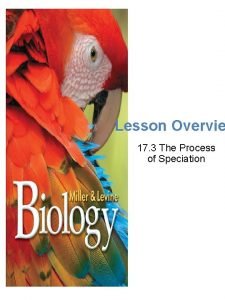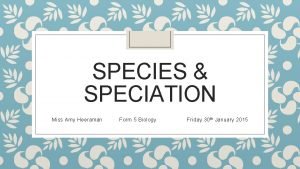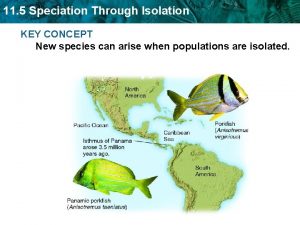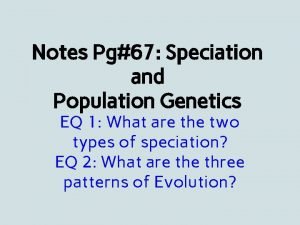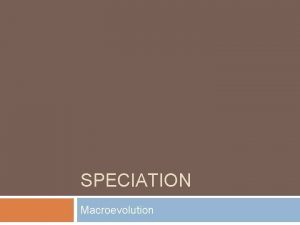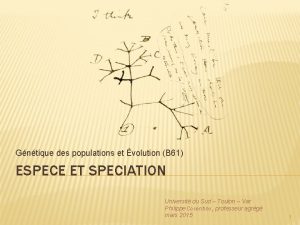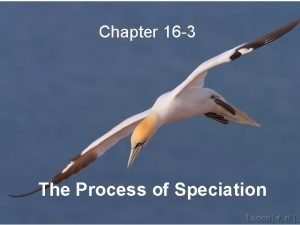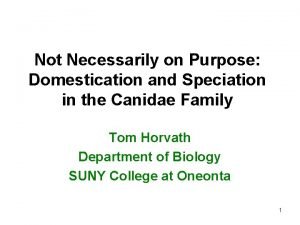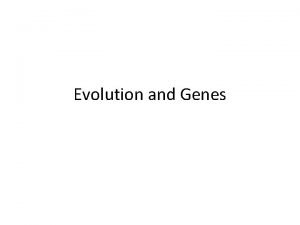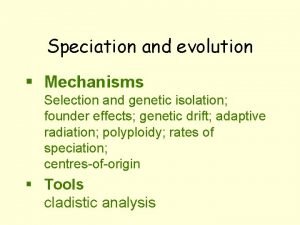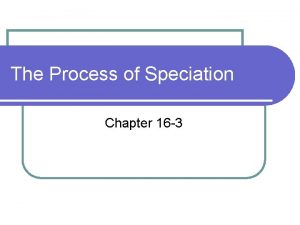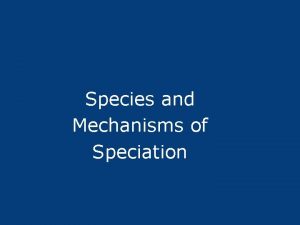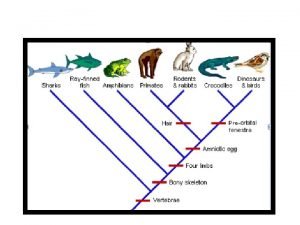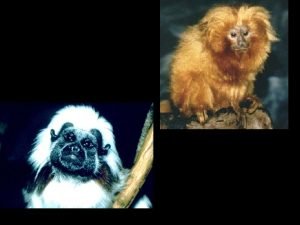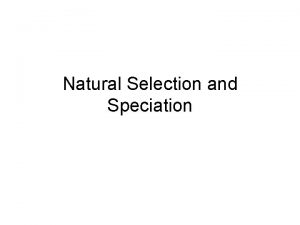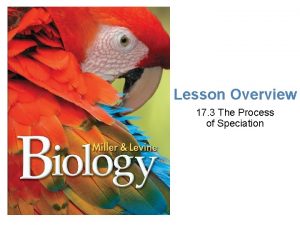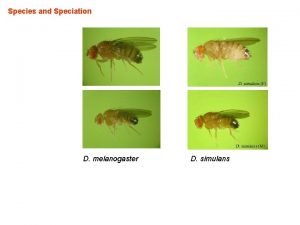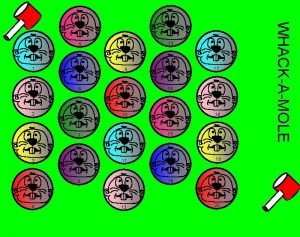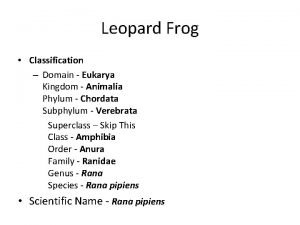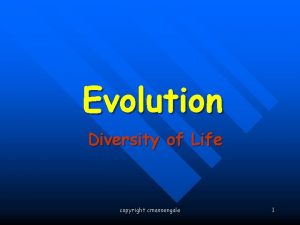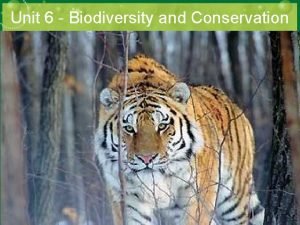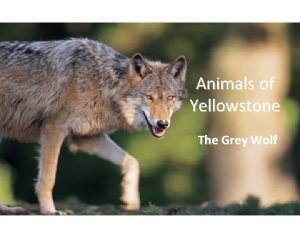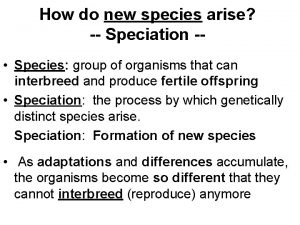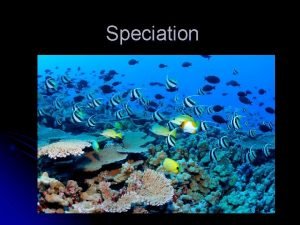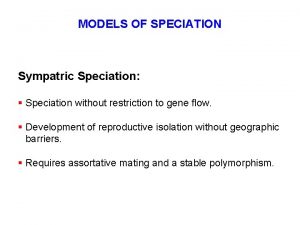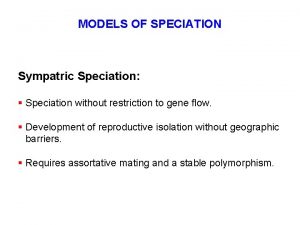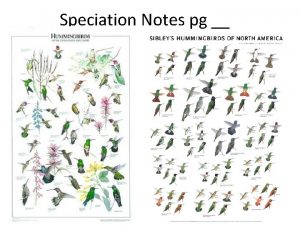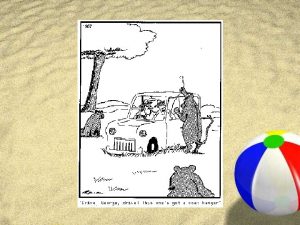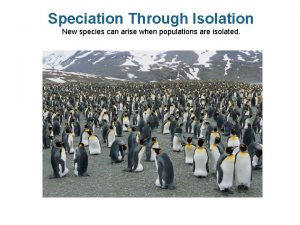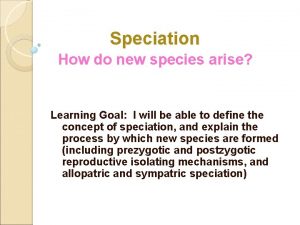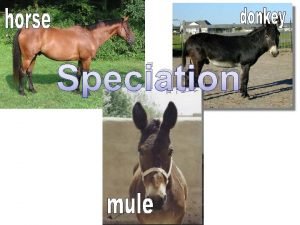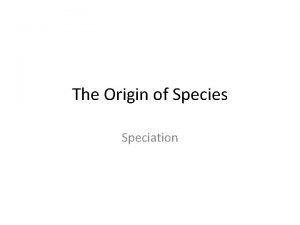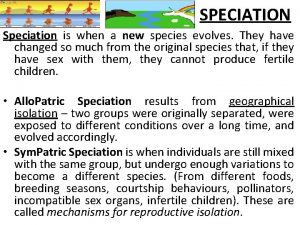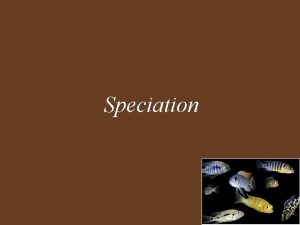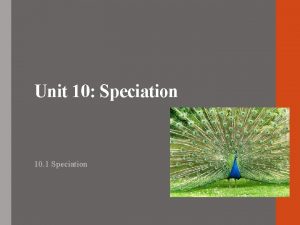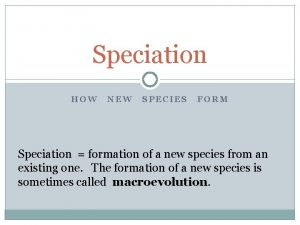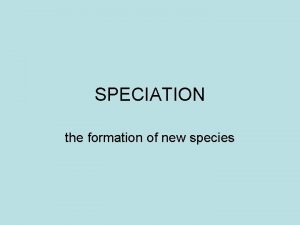SPECIATION What is species How do species arise































































- Slides: 63

SPECIATION

What is species? How do species arise?


Eurasian nuthatch (Sitta europea) x x common treecreeper (Certhia familiaris) Mechanisms maintaining species integrity

European herring gull (Larus argentatus) lesser black-backed gull (L. fuscus)


Antics: species unstable and highly variable

Are species real entities? nominalists: no universals and abstract objects (= only words), only particulars exist eg. William of Ockham, popular in France in the 1700 s (young Buffon and Lamarck), Darwin species are human abstractions, artificially dividin natural continuum

according to Darwin classification of organisms to a large extent arbitrary:

realists: only universals are real, particulars are derived, random, variable, and ephemeral eg. Plato species really exist in nature

New Guinea tribes: Karam people almost identical discrimination of bird species with western taxonomists (but bats considered as birds) Rofaifo people only two names for mammals (small = Hunembe, big = Hefa); cassowary considered as a mammal human brain same in aborigines and professional taxonomists free hybridization within species rare between species Problem: definition should be both universal and operational

Typological (essentialist) concept Plato´s world of ideas: assumption of existence of limited number of types (universals) species composed of idividuals having the same essence variability strongly limited, results from imperfekt expression of the idea each species separated from others by sharp boundary constant in time

sexual dimorphism male Bonellia viridis angler (Lophius piscatorius)

polymorphism, different ontogenetic stages Heliconius spp. Papilio polyxenes Ranitomeya imitator

sibling species, cryptic species Drosophila persimilis/ D. pseudoobscura Pipistrellus pipistrellus/P. pygmaeus Certhia brachydactyla/C. familiaris

Typological species still in nomenclatorial practice: type specimen = holotype, type series, type locality barcoding

Biological species concept (BSC) T. Dobzhansky, H. Muller, J. Huxley, E. Mayr species as gene pools, reproductive communities reproductively isolated from others no constant, „essential“ characters E. Mayr

Ernst Mayr (1942): Species are groups of interbreeding natural populations that are reproductively isolated from others such groups. liger free mating reproductive barrier free mating X tigon

Limitations and problems of biological species: only sexual organisms problems in allopatry („potential“ hybridization) auxiliary morphological and genetic criteria (degree of divergence degree of reproductive isolation) problems in palaeontology – populations are not contemporary hybridization between „good“ species (Bombina bombina B. variegata) auxiliary criteria (DNA sequences)

Q. grisea Quercus gambelii grisea + gambelii = syngameon

Reproductive barriers formerly reproductively isolating mechanisms = RIM. . . today we prefer the term reproductive barriers (RIM imply „in order to“)! 1. Prezygotic A) pre-copulatory: partners do not meet: seasonal (temporal) eg. fireflies, crickets Gryllus pennsylvanicus (autumn) G. veletis (spring)

Reproductive barriers ecological (habitat): Viola arvensis (chalk soils) V. tricolor (acidic soils), hybrids limited to neutral or weakly acidic soils

Reproductive barriers 1. Prezygotic A) pre-copulatory: mediterranea partners meet but do not mate: ethological, behavioral, sexual signals: - acoustic lucasina johnsoni lacewing (Chrysoperla) carnea zastrowi arabica

1. Prezygotic Reproductive barriers A) pre-copulatory: partners meet but do not mate: ethological, behavioral, sexual signals: - acoustic - chemical - light firefly´s track

1. Prezygotic A) pre-copulatory: partners meet but do not mate: ethological, behavioral, sexual signals: - acoustic - chemical - light - behavioral (eg. wedding dances) Reproductive barriers

grey-crowned crane (Balearica regulorum) great bustard (Otis tarda) black-necked stilt (Himantopus mexicanus) red-crowned crane (Grus japonensis) western grebe (Aechmophorus occidentalis)

signals: - acoustic - chemical - light - behavioral (eg. wedding dances) - different pollinators in plants Reproductive barriers

Reproductive barriers 1. Prezygotic B) post-copulatory: partners mate but without transfer of gametes: mechanical: - especially plants; in animals shape of genitalia cat fox os penis walrus (fossil: 1, 2 m and recent: 56 cm) mink racoon

1. Prezygotic Reproductive barriers B) post-copulatory: transfer of gametes occur but without fertilization: gametic incompatibility external fertilization: esp. marine invertebrates (mollusks, echinoderms) internal fertilization: eg. Drosophila – sperm cannot survive in spermatheca of females of other species plants: pollen tube grows through style

2. Postzygotic inviability of F 1 hybrids sterility of F 1 hybrids reduced viability or fertility of F 2 or backcrosses = hybrid dysgenesis Haldane´s rule: When in the F 1 offspring of two different animal races one sex is absent, rare, or sterile, that sex is the heterozygous (heterogametic) sex. *) *) Drosophila – males (XY); Abraxas – females (WZ)

Haldane´s rule explains Large X effect: genes having large impact on postzygotic reproductive isolation are usually located on X chromosome dominance theory (Muller 1940, 1942; Orr 1997): males – both dominant and recessive alleles of X-linked genes females – only dominant alleles Drosophila pseudoobscura D. persimilis

Rate of prezygotic isolation between allopatric species is similar to rate of postzygotic isolation. . . both sympatric and allopatric sympatric allopatric . . . prezygotic isolation between sympatric/parapatric species arises more rapidly

Concepts related to biological species: Recognition species concept Hugh E. H. Paterson (1985) empasizes shared fertilization system rather than isolation: specific mate recognition system (SMRS) courtship, timing of mating, choice of condition, coloration, endocrine system, shape of copulatory organs, gametic compatibility, … reproductive isolation as a byproduct

Concepts related to biological species: Cohesion species concept Alan R. Templeton (1989) empasizes mechanisms maintaining morphological stability of populations cohesion mechanisms: gene flow, stabilizing selection, ontogenetic constraints, reproductive isolation aplication also to asexual organisms, possibility of interspecific hybridization

Evolutionary species concept attempts for vertical species concepts George Gaylord Simpson (1961): phyletic speciation, chronospecies asexual organisms temporal perspective biological species is a part of it Edward O. Wiley (1978): „A species is a lineage of ancestral descendant populations which maintains its identity from other such lineages and which has its own evolutionary tendencies and historical fate. “ contrary to Simpson´s concept Wiley admits only cladogenesis, ie. splitting speciation

Phylogenetic species concept emphasis on diagnostic criteria but which ones? primary inference of phylogeny (synapomorfies) Phylogenetic species = smallest monophyletic group distinguished by a shared derived trait

Relation of biological and phylogenetic species: biological species A biological species B B 1 B 2 RI origin of reproductive barrier X A C

Relation of biological and phylogenetic species: phylogenetic species C phylogenetic species B B 1 B 2 RI X origin of synapomorfy A C

SPECIATION geography: allopatric (isolation) sympatric (no isolation) mechanism: allopatric peripatric allo-parapatric (reinforcement) parapatric sympatric drift selection sexual selection hybridisation polyploidisation genetic elements: genes vs. chromosomes (stasipatric speciation)

Allopatric speciation geographic isolation advancing divergence: mutation, drift, selection, sexual selection reproductive barriers as a byproduct

original population geographic barrier mutation drift selection divergence incompatibility

Dobzhansky-Muller model: W. Bateson 2 genes: aabb a-B compatible T. Dobzhansky a. Abb H. Muller AAbb A-b compatible aa. Bb AABB aa. BB A-B incompatible

large population allopatric speciation usually slow (exceptions: sexual selection, genetic conflict) genetic conflict: subpop. 1 arms race in ancestral population ongoing arms race subpop. 2 incompatible! secondary contact

co-speciation (parasite-host): Syphacia microsatellite markers hybrids 1 0, 9 0, 8 0, 7 0, 6 0, 5 0, 4 0, 3 0, 2 0, 1 0 1 6 11 16 21 26 31 36 41 46 51 56 61 66 71 76 81 86 91 96 101 106 111 116 121 126 131 136 141 146 151 156 161 166 171 176 181 186 191 196 201 206 211 216 221 J. Goüy de Bellocq Wasimuddin

Peripatric speciation (founder-effect speciation) Mayr: founder effect island organisms, peripheral isolates (extinction-recolonisation)

genetic revolution rapid speciation


founder-flush model: Drosophila colonisation of a novel environment – no selection rapid divergence

Allo-parapatric speciation (reinforcement speciation) A. R. Wallace, R. A. Fisher, T. Dobzhansky secondary hybrid zone initial geographic isolation reproductive isolation incomplete secondary hybrid zone

selection against hybrids formation of prezygotic barrier strenghtening of isolation (reinforcement) = Wallace´s effect faster isolation in contact allopatric pairs both sym/parapatric and allopatric pairs

Vošlajerová Bímová et al. (2011) Both female and male preference show reinforcement in the zone centre prezygotic barrier probably contributes to reproductive isolation

Parapatric speciation a A A A a a a ecotone environmental gradient genetic gradient primary hybrid zone different selection in the two parts genetic divergence even with gene flow

Sometimes difficult to distinguish allopatric and parapatric speciation: ring species

ring species: Larus Ensatina Phylloscopus

ring species: European herring gull (Larus argentatus) and lesser black-backed gull (L. fuscus)

ring species: greenish warbler (Phylloscopus trochiloides)

ring species: Ensatina e. xanthoptica Ensatina e. klauberi Ensatina eschscholtzii

Sympatric speciation Polyploidisation 2 N 4 N = 3 N 2 N 4 N aneuploid hybrids Host shift R. pomonella apple magot (Rhagoletis pomonella): hawthorn 1866 apple ca. 1960 cherry peer, rose, plum etc. assortative mating, genetic differences, different incubation period (seasonal isolation) absence of postzygotic mechanisms

Final overview: allopatric peripatric

Rate of speciation: allopatric speciation usually slow rapid speciation and adaptive radiation: Darwin´s finches fruit flies in Hawaii cichlids in African lakes

Great Rift Valley – Viktoria, Malawi, Tanganyika; Viktoria: 400 000 years, 17 300 – drying, 14 700 re-creation; molecular clock: ancestor of cichlids – 100 000 years

Cameroon: Barombi Mbo (4, 2 km 2) – 11 species, Bermin (0, 6 km 2) – 9 cichlid species, monophyletic origin, absolute isolation, ancestor – 10 000 years Barombi Mbo Bermin

Paralel speciation habitat shift role of natural selection role of sexual selection (cichlids)
 Sympatric speciation vs allopatric speciation
Sympatric speciation vs allopatric speciation Describe the conditions under which new species may arise.
Describe the conditions under which new species may arise. Speciation, or the formation of new species, is
Speciation, or the formation of new species, is Capitate antennae
Capitate antennae List verbs participle
List verbs participle Let praise arise
Let praise arise How to arise and shine
How to arise and shine Arise to greet the lord of light
Arise to greet the lord of light Why do territorial conflicts arise among religious groups
Why do territorial conflicts arise among religious groups Panchal cast
Panchal cast How did the ottoman safavid and mughal empires arise
How did the ottoman safavid and mughal empires arise Why might fishing disputes arise in the region?
Why might fishing disputes arise in the region? Themes of the lake isle of innisfree
Themes of the lake isle of innisfree Arise due to
Arise due to Price is greater than marginal cost in monopoly
Price is greater than marginal cost in monopoly Oh church arise
Oh church arise Keystone species definition biology
Keystone species definition biology Hybrid fertility
Hybrid fertility The sixth extinction chapter 3 summary
The sixth extinction chapter 3 summary Section 16–3 the process of speciation (pages 404–410)
Section 16–3 the process of speciation (pages 404–410) Speciation modes answer key
Speciation modes answer key Parapatric speciation
Parapatric speciation Ecological speciation
Ecological speciation Speciation types
Speciation types Allopatric speciation example
Allopatric speciation example Habitat isolation
Habitat isolation Parapatric speciation
Parapatric speciation Population genetics and speciation worksheet answer key
Population genetics and speciation worksheet answer key La spéciation
La spéciation Section 16–3 the process of speciation
Section 16–3 the process of speciation Mechanical isolation
Mechanical isolation Modes of speciation ppt
Modes of speciation ppt Ring species
Ring species Dérive genetique
Dérive genetique The origin of species chapter 18 manga
The origin of species chapter 18 manga Factors affecting gene frequency slideshare
Factors affecting gene frequency slideshare Huahaca
Huahaca Parapatric speciation
Parapatric speciation Sympatric speciation
Sympatric speciation Speciation
Speciation Speciation process
Speciation process Biological species concept
Biological species concept Section 5 speciation through isolation
Section 5 speciation through isolation Speciation
Speciation Speciation process
Speciation process Speciation ecureuil antilope
Speciation ecureuil antilope Section 16-3 the process of speciation
Section 16-3 the process of speciation Fox cladogram
Fox cladogram Parapatric speciation
Parapatric speciation Speciation
Speciation Section 16-3 the process of speciation
Section 16-3 the process of speciation Speciation definition biology
Speciation definition biology Sympatric speciation def
Sympatric speciation def Horizontal gene transfer
Horizontal gene transfer Directional selection
Directional selection Speciation process
Speciation process Embryo development
Embryo development Morphological species concept
Morphological species concept Exponential growth would be represented by a ____ curve
Exponential growth would be represented by a ____ curve External nares frogs
External nares frogs Copyright
Copyright Species diversity
Species diversity Wolf classification
Wolf classification Kingdom phylum class order
Kingdom phylum class order
